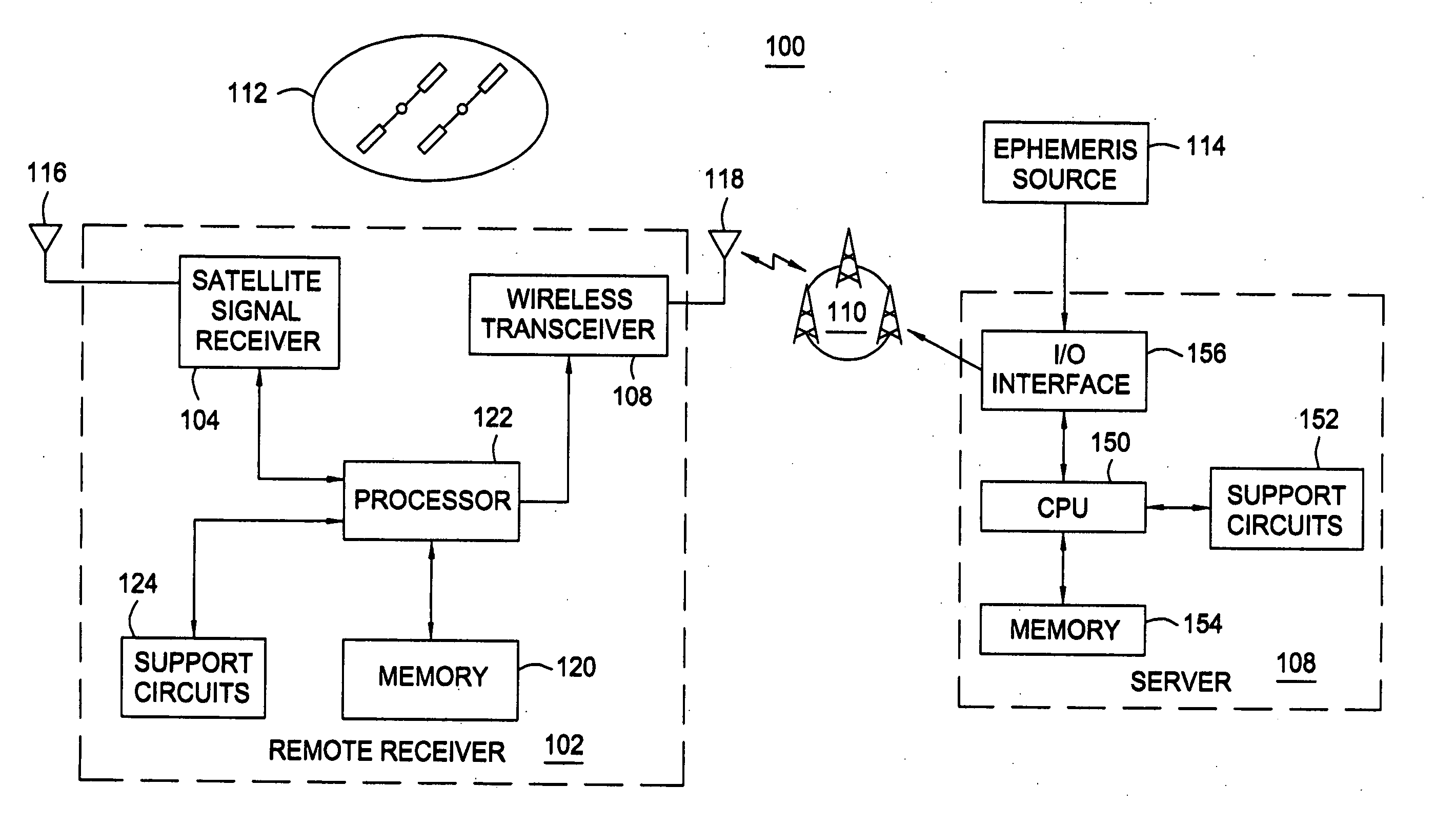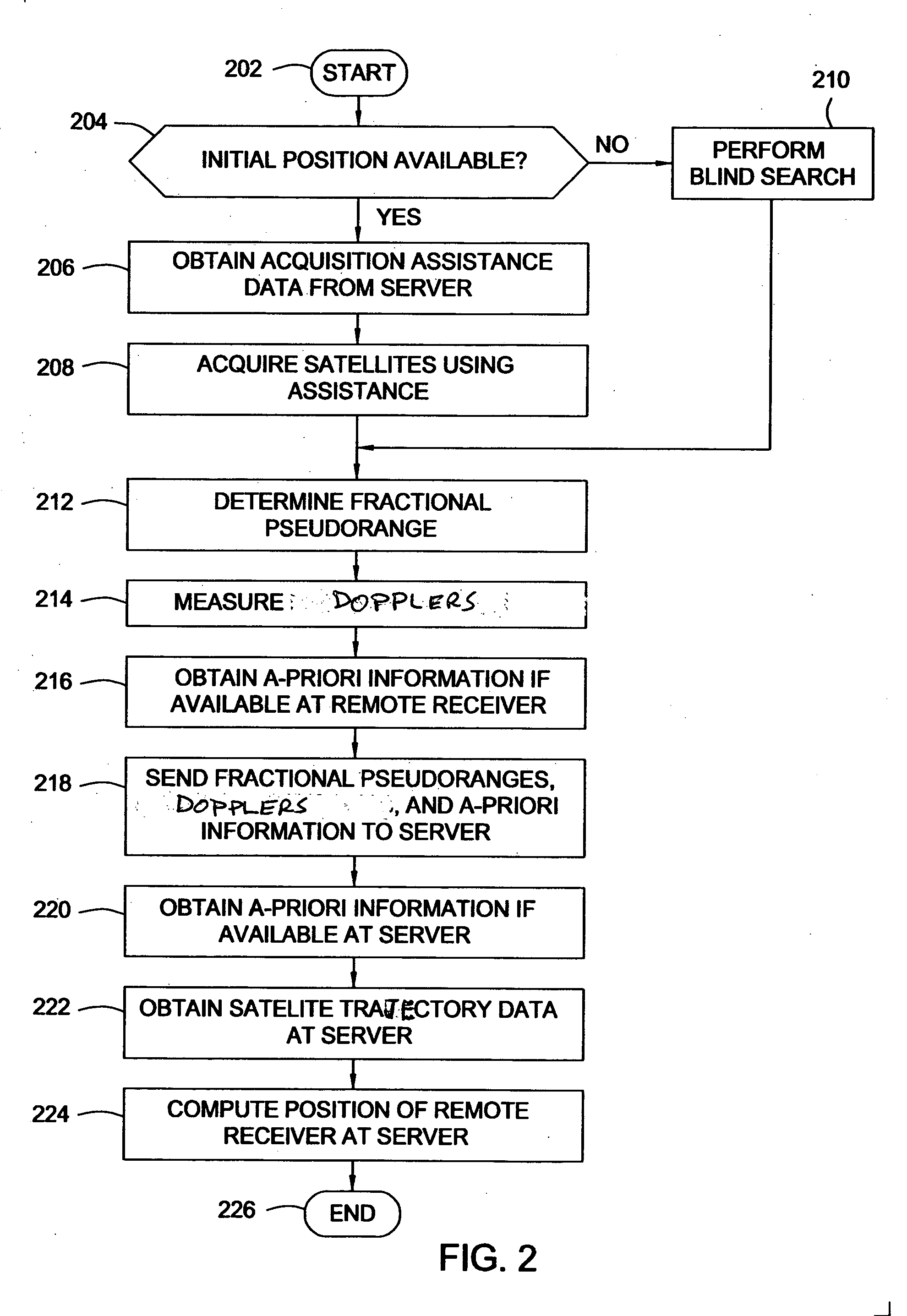Method and apparatus for computing position using instantaneous doppler measurements from satellites
a satellite and instantaneous doppler technology, applied in the field of satellite positioning systems, can solve the problems of large position errors, large range errors of up to 0.8 m, and similar sized errors in the position of the gps receiver
- Summary
- Abstract
- Description
- Claims
- Application Information
AI Technical Summary
Problems solved by technology
Method used
Image
Examples
first embodiment
[0046] More specifically, in a first embodiment, a first fix for position of the remote receiver 102 is computed by the server 108 with a single satellite, given a-priori knowledge of the clock and velocity unknowns and a-priori knowledge of approximate position. In this embodiment a full-pseudorange and a Doppler measurement are obtained from the satellite. This embodiment may arise in practice if the remote receiver 102 is integrated within a cell-phone and has access to a wireless communication system. An initial position of the remote receiver 102 may be obtained as discussed above. Precise time and frequency may be obtained from the wireless communication network 110, providing a-priori knowledge of tC, tS, and fc. A-priori knowledge of velocity may be obtained either from an external measurement, or by assuming velocity equals zero (often a good assumption when the remote receiver 102 is being used by a person on foot). Of the nine unknowns (x,y,z, {dot over (x)},{dot over (y)...
second embodiment
[0052] In a second embodiment, a first fix of position is obtained using two satellites, given a-priori knowledge of approximate position, but no a-priori knowledge of the clock unknowns. In this embodiment, full-pseudoranges and Doppler measurements are obtained from the two satellites. An initial position is obtained as described above. The unknown velocity may be obtained either from an external measurement, or by assuming velocity equals zero. The position of the remote receiver 102 is computed, as described algebraically below.
[0053] The absolute time-tag error (tS) may be obtained either from an external source, such as the wireless communication network 110 if the system is synchronized to GPS time, or by decoding the Handover Word (HOW) from the satellite signals. The altitude parameter (z) may be obtained from the a-priori position information, or by using a terrain model as described above. This leaves four unknowns: x, y, tC and fC. The four unknowns are related to the Do...
third embodiment
[0056] In a third embodiment, a first fix for position is obtained using two satellites, without a-priori knowledge of the clock unknowns and without a-priori knowledge of approximate position. In this embodiment, full-pseudoranges and Doppler measurements are obtained from the two satellites. No a-priori information is obtained by either the remote receiver 102 or the server 108. Thus, an initial position must be estimated. The estimate of initial position may be based on some knowledge of the general region (example, the country, or continent) in which the remote receiver 102 is operating, or may simply be set to the center of the earth. Then, one iteration of the mathematical model described above will produce a position that is a better estimate than the estimated initial position. This result is then used as a better a-priori position, and the process is repeated (using the same measurements, but the new a-priori position). Typically only a few iterations (e.g., fewer than 10) ...
PUM
 Login to View More
Login to View More Abstract
Description
Claims
Application Information
 Login to View More
Login to View More - R&D
- Intellectual Property
- Life Sciences
- Materials
- Tech Scout
- Unparalleled Data Quality
- Higher Quality Content
- 60% Fewer Hallucinations
Browse by: Latest US Patents, China's latest patents, Technical Efficacy Thesaurus, Application Domain, Technology Topic, Popular Technical Reports.
© 2025 PatSnap. All rights reserved.Legal|Privacy policy|Modern Slavery Act Transparency Statement|Sitemap|About US| Contact US: help@patsnap.com



